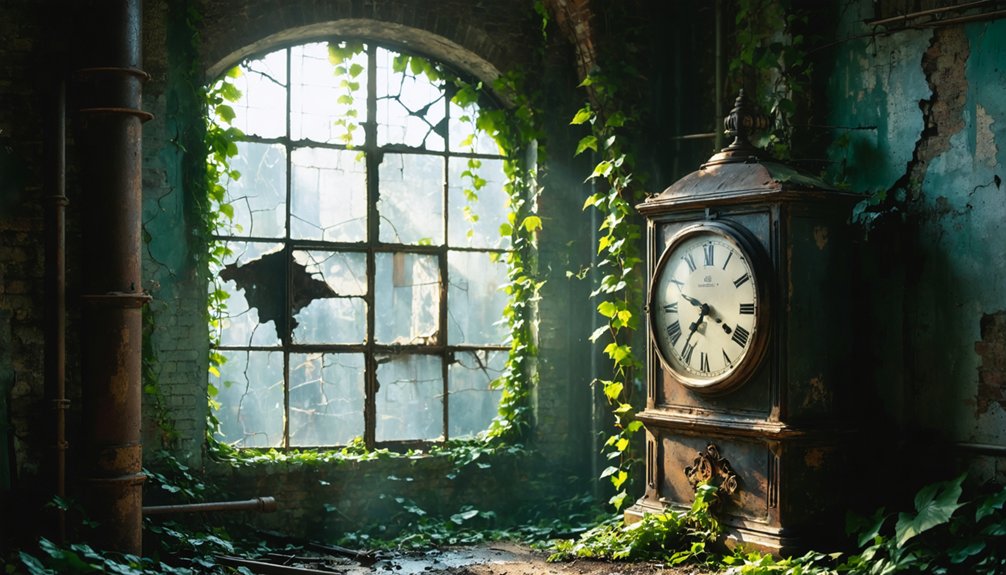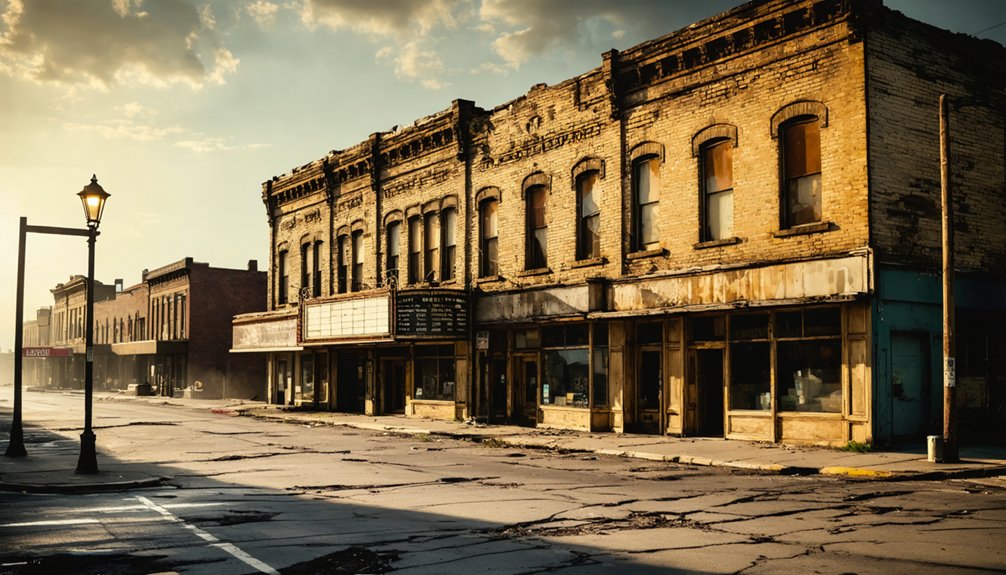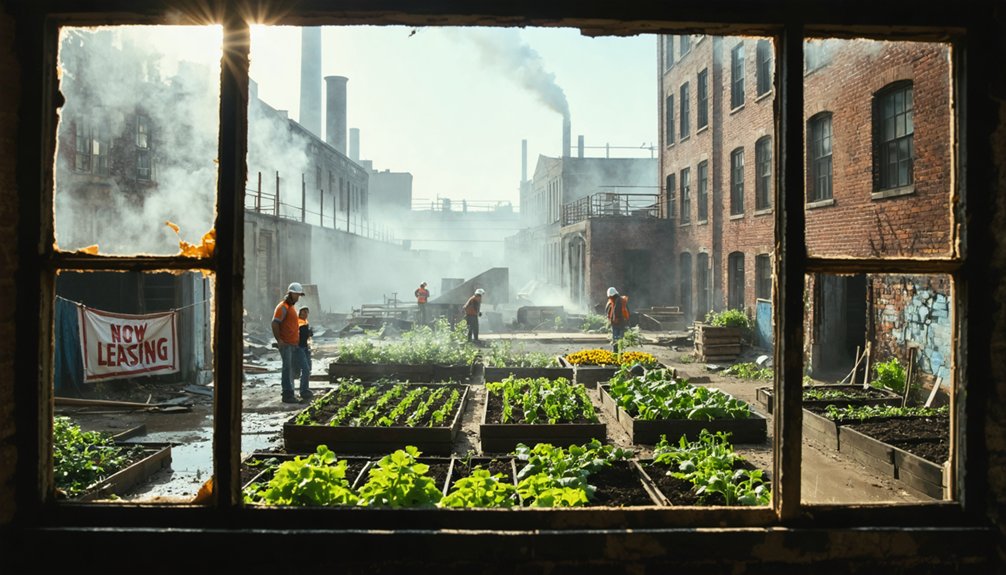When exploring Rust Belt ghost towns, research their industrial history first, pack safety gear including boots and respirators, verify legal access, document with quality photography, connect with local historical societies, leave only footprints, and understand the economic forces that created these haunting landscapes. As you stand before abandoned factories and empty storefronts, you’re witnessing the physical remnants of America’s manufacturing decline—each crumbling structure has a story waiting to be uncovered.
Key Takeaways
- Research property ownership and obtain proper permissions before exploring abandoned sites to avoid trespassing issues.
- Wear protective gear including sturdy boots, gloves, and respirators to shield against hazards like rusty nails and toxic materials.
- Document your exploration through photography during golden hours and maintain field notes without disturbing or removing artifacts.
- Connect with local historical societies and community members to gain valuable context and potentially secure legal access.
- Inspect structures for stability hazards like sagging roofs or leaning walls before entering, and always bring emergency supplies.
Research Before You Go: Historical Context Matters
Before you pack your camera and don your exploring boots for a Rust Belt ghost town adventure, you’ll need to understand the complex tapestry of history that created—and ultimately emptied—these once-thriving industrial centers.
The historical significance of these abandoned landscapes traces back to the Erie Canal (1825) and railroad expansions that transformed small towns into industrial powerhouses like Pittsburgh, Detroit, and Cleveland. European immigrants and African Americans during the Great Migration built these cities, only to witness their collapse from the 1950s-1980s as foreign competition, technological changes, and deindustrialization took hold.
Your urban exploration will reveal neighborhoods where racial inequities determined which areas emptied first—many Black communities faced systematic discrimination through urban renewal projects and lending practices. Many cities implemented urban renewal initiatives that prioritized corporate interests over existing residents, leading to displacement and further community decline. Always check local historical records to determine if the site you plan to visit sits on private property before setting out on your exploration journey.
Understanding these patterns helps you recognize the human stories behind each abandoned factory, bowling alley, and empty main street.
Safety First: Essential Gear and Precautions
Understanding the stories behind these forgotten places won’t keep you safe while exploring them. Venture prepared with sturdy hiking boots to protect against rusty nails and broken glass lurking beneath debris.
Don’t skimp on protective gear—heavy-duty gloves and long clothing shield against hazardous materials while respirators prevent inhaling toxic mold and asbestos. Be aware that many ghost towns contain hazardous materials that can cause serious health issues with prolonged exposure. Take time to inspect for stability by checking for sagging roofs and leaning walls before entering any structure.
Proper protection isn’t optional—your lungs and skin deserve heavy-duty barriers between them and invisible dangers lurking in decay.
Always carry a headlamp even during daylight hours—dark corners hide dangerous structural failures. Download offline maps and mark your path with chalk to maintain orientation in labyrinthine structures.
Your vehicle becomes your lifeline, so pack emergency supplies including first aid kits, three days’ water, and vehicle recovery equipment.
Doorstops aren’t just conveniences—they’re safety tools preventing accidental entrapment. Before entering any structure, assess its stability; no photo is worth risking your life under a collapsing ceiling.
Where legal boundaries begin and trespassing starts can make the difference between an enriching exploration and a costly court date. Before venturing into any Rust Belt ghost town, verify property ownership through local historical societies or county records. Posted signs aren’t suggestions—they’re legal boundaries demanding respect.
Many fascinating structures sit on private land, requiring explicit permission from owners. Don’t assume abandoned means accessible. Many abandoned properties in these areas are the result of owners walking away when taxes exceeded property value, creating a complex ownership situation. Once-thriving manufacturing centers have seen dramatic population decline due to deindustrialization, leaving behind vacant properties with unclear ownership. Research access regulations through state historical records and obtain necessary permits for protected sites.
Remember that photography may be restricted at certain locations, and removing artifacts is almost always illegal.
When uncertain about boundaries, contact local authorities. Document any permissions you receive and stick to established paths. Your freedom to explore tomorrow depends on respecting these legal boundaries today.
Document Your Journey: Photography and Field Notes
Through the crumbling facades and silent factory floors, your camera becomes both witness and storyteller in these forgotten landscapes. Capture the soul of these places by bringing a DSLR or mirrorless camera with wide-angle lenses for expansive scenes and primes for telling details.
During golden hours, the slanting light reveals textures that daytime flattens—peeling paint, rusted machinery, and nature’s slow reclamation.
Your field notes are equally essential. Document historical context, GPS coordinates, and personal reflections in a dedicated notebook. These records transform random images into a cohesive narrative.
Note lighting conditions that might warrant a return visit, and record the stories behind architectural details or found objects. Exploring different angles and perspectives will create a more diverse and compelling portfolio of images. A sturdy tripod provides essential stability when capturing low-light interiors or creating long-exposure shots that convey the passage of time.
Always pack extra batteries, memory cards, and proper lighting for dark interiors. Remember, your photography techniques preserve these vanishing worlds for future generations.
Connect With Local Communities and Historical Societies
Beyond the silent corridors and weathered storefronts lies the true heartbeat of any ghost town—its community memory.
You’ll uncover far richer discoveries by establishing historical partnerships with local societies who maintain invaluable archives of maps, photographs, and documents that illuminate your exploration.
Seek out community engagement opportunities through nonprofits organizing heritage events, or connect with residents whose personal stories reveal perspectives absent from formal records. Organizations like PUSH Buffalo demonstrate how door-to-door outreach can effectively gather resident input and foster community ownership over revitalization efforts. These connections emphasize clear communication when sharing information about preservation initiatives.
Their knowledge not only enriches your understanding but also helps navigate safety concerns and access permissions.
Don’t overlook academic collaborations with regional universities studying urban decline, as they offer structured exploration opportunities and research tools.
These connections transform you from mere visitor to contributing participant in the ongoing story of these forgotten places—preserving their legacy while respecting those who still call these regions home.
Preserve the Past: Ethical Exploration Practices
The stories captured through community connections must be matched with responsible actions when you step into these fragile time capsules.
Ethical considerations should guide every footfall as you navigate crumbling factories and abandoned homes—each structure holds memories deserving respect.
Sustainable tourism in these atmospheric landscapes means:
- Never removing artifacts—capture their essence through photography instead
- Staying on marked paths to prevent further structural deterioration
- Respecting private property boundaries and obtaining permissions
- Documenting conditions without disturbing the natural reclamation process
Your freedom to explore comes with responsibility.
These silent sentinels of industrial history whisper stories of prosperity and decline; your mindful presence guarantees they’ll continue speaking to future explorers who seek the authentic, untouched character of America’s forgotten places.
Understanding the Economic Forces Behind Abandonment

While you explore these hauntingly quiet streets and peer through broken factory windows, invisible economic forces tell the real story of why these once-thriving communities now stand frozen in time.
What you’re witnessing is the aftermath of decades of economic decline that began in the 1950s—automation replacing workers, factories moving south, and eventually overseas following trade agreements like NAFTA.
As manufacturing jobs disappeared, so did the people. Communities like Bruceton lost 1,700 textile jobs, while entire regions saw population plummet by nearly half.
The job migration created a domino effect: shrinking tax bases, crumbling infrastructure, and increasing social problems. Each abandoned home represents a family forced to seek opportunity elsewhere, leaving behind not just buildings but the fragments of once-vibrant communities now silenced by global economic shifts.
Frequently Asked Questions
How Do Ghost Towns Differ Between Northern and Southern Rust Belt Regions?
You’ll find northern towns defined by industrial urban decay with massive factories, while southern ghost towns reveal historical significance through rural extractive industries nestled in Appalachian landscapes, each telling unique rust-stained stories.
What Wildlife Hazards Are Common in Abandoned Industrial Sites?
You’ll face rodents, raccoons, snakes, and feral cats during wildlife encounters in decaying factories. These creatures nest among hazardous materials, creating dangerous situations when you’re venturing through overgrown industrial ruins.
Can Metal Detecting Be Done Ethically in Ghost Towns?
You can ethically metal detect if you’ve secured written permission, photograph rather than remove finds, and prioritize historical preservation. Your adventures shouldn’t erase the rust-stained stories these weathered towns still whisper.
Are There Seasonal Considerations That Affect Ghost Town Exploration?
You’ll face changing weather conditions throughout the year—icy winters restrict access, spring brings floods, summer offers overgrown paths hiding dangers, and fall’s temperature fluctuations accelerate structural decay. Plan your adventure accordingly.
How Have Former Residents Documented Their Experiences of These Towns?
Coincidentally, you’ll find former residents’ souls preserved through oral histories, hand-written memoirs, and archival photographs. They’ve captured faded memories in detailed diaries, intimate letters, and community scrapbooks, immortalizing their vanished worlds forever.
References
- https://en.wikipedia.org/wiki/List_of_ghost_towns_in_Pennsylvania
- https://www.withoutapath.com/travel-guides/rust-belt/
- https://www.lovemoney.com/gallerylist/86648/americas-empty-ghost-towns-and-why-theyre-abandoned-today
- https://hiddenbritainse.org.uk/what-i-learned-from-ghost-town-exploration/
- https://www.geotab.com/ghost-towns/
- https://en.wikipedia.org/wiki/Rust_Belt
- https://247wallst.com/special-report/2018/11/02/30-american-ghost-towns-3/
- https://www.loveexploring.com/gallerylist/127789/then-and-now-us-rust-belt-cities-that-bounced-back
- https://globalurbanhistory.com/2016/02/01/the-spiritual-capital-of-the-rust-belt-pittsburgh-and-the-postindustrial-transformation-of-north-atlantic-cities/
- https://www.youtube.com/watch?v=3yF7rHBNtx0



